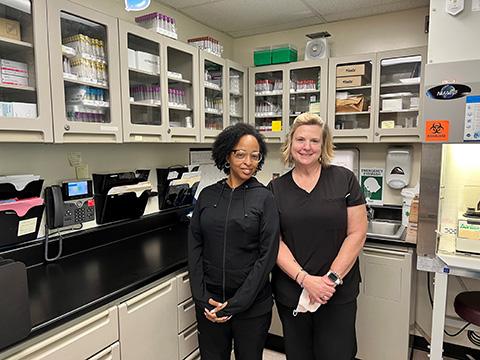Look at your fingernails. What comes to mind? Now look at the veins in your arms. What about them?
Odds are the words “critical” and “historic” aren’t your first thoughts, but they’d be an apt description.
At NCI at Frederick and Frederick National Laboratory, nail clippings and blood specimens are two ways to make a difference in scientific research. They’re among the types of samples the Research Donor Program (RDP) collects to advance investigators’ studies of cancer, HIV, and other diseases.
And now, thanks to logistical challenges brought on by the pandemic, they’re desperately needed.
“[Donors] have an opportunity to play a big role in history. They get to leave an impact,” said Jim Cherry, Ph.D., an RDP donor and an associate director and chief at the National Institute of Allergy and Infectious Diseases. (Cherry was formerly a scientific program director at NCI at Frederick.)
The long-standing program compensates volunteer donors for contributions of their own blood, buccal (cheek swab) cells, nail clippings, semen, and urine. These samples are delivered on demand to scientists at NCI at Frederick and Frederick National Laboratory, who use them in research ranging from virology to genetics to drug screening.
Ligia Pinto, Ph.D., director of the Vaccine, Immunity, and Cancer Directorate at Frederick National Laboratory, knows the difference the donations make, calling the program “irreplaceable.” Not only is she a donor, her team has used serum samples from the program as controls to develop and evaluate SARS-CoV-2 and human papillomavirus (HPV) antibody assays.
That contributed to critical work to establish HPV serology standards and, in the first year of the COVID-19 pandemic, the SARS-CoV-2 U.S. Serology Standard. The SARS-CoV-2 standard has since become a resource used internationally by scientists seeking to better understand SARS-CoV-2 and end the pandemic.
“This blood is being used for critical science. [It’s] enabling and building science,” Pinto said. “Also, the [Occupational Health Services] nurses are truly amazing partners, and their interest and commitment have been critical for the success of the program.”
Sole Source
For many of the 25 investigators who partner with the program, there’s no other place to get these samples. Vendors either don’t sell them, or if they do, the samples are prohibitively costly or must be shipped long distances, which risks their being too old by the time they arrive.
“We would have to outsource all our normal controls. That would need to be done from many sources by multiple subcontracts, which would be very time consuming and complicated,” said Michael Baseler, Ph.D., director of the Applied and Developmental Research Directorate, which uses RDP samples as controls in clinical labs.
He added, “The associated costs would be significantly higher, resulting in perhaps not monitoring as many clinical trials.”
The Occupational Health Services staff operates the RDP out of the Building 426 clinic on the NCI at Frederick campus. Samples often can be delivered to laboratories on campus and at the Advanced Technology Research Facility the same day they’re collected.
“It’s extremely important to us. Many of the data we have published in the past few years would not have been obtainable without the help of RDP participants,” said Denise Whitby, Ph.D., senior principal scientist in the AIDS and Cancer Virus Program.
Whitby’s laboratory uses RDP samples as healthy controls in Kaposi sarcoma–associated herpesvirus (KSHV) research. KSHV causes Kaposi sarcoma in certain high-risk populations and causes significant disease burden, especially in parts of Africa and in people living with HIV in the U.S. The RDP samples from donors with and without KSHV allow the team to better understand how the immune system interacts with the virus.
Most RDP samples are used for controls, assay development, or certain comparative studies. Scientists like Pat Martin, M.D., of the Basic Science Program, say that sample availability has been indispensable for seamlessly performing experiments. She and her colleagues study genetic variations among different populations of people. Thanks to the RDP, they can design physiologically relevant studies using fresh samples, a gold standard in genetics research.
“The value of the [RDP] cohort to scientists has been enormous. It has been invaluable in moving our research forward,” Martin said.
‘White-Glove Service’
The RDP’s importance isn’t lost on the Occupational Health Services nurses who operate it. For the team in the Building 426 clinic, it’s more than another part of the job. Everything is handled with the utmost scientific rigor.
“It’s white-glove service. They absolutely tailor the donor pool to the needs of the requester. They get the samples so they’re fresh right when [the scientists] want them,” said Janelle Cortner, Ph.D., the RDP principal investigator and protocol writer. The nurses also safeguard donors’ privacy and data.
But it comes with a distinctly human touch, too. The donors are more than just donors. They’re partners, trusted associates, and—often—friends.
“When we say our donors are like family, we sincerely mean that. We laugh with them, cry with them, share stories with them, and appreciate them. Without donor participation, our program would not exist,” said Trish Claude, RDP team lead and Occupational Health Services nurse, on behalf of the team.
And without the program, much research against disease wouldn’t exist, either.
The RDP is open to employees, contractors, and anyone who can access the NCI at Frederick campus within Fort Detrick. NCI and FNL employees can find more information on the RDP web page, as can investigators seeking to partner with the program.
Samuel Lopez is a technical editor in Scientific Publications, Graphics & Media (SPGM), where he writes for newsletters, including as managing editor of Poster; informally serves as an institutional historian; and edits scientific manuscripts, corporate documentation, and a slew of other written media. SPGM is the creative services department and hub for editing, illustration, graphic design, formatting, multimedia, and training in these areas.


